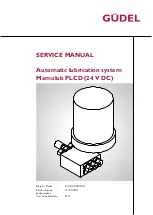
Technical data
Section 2 – Operating Instructions
Rev. 2.8 Date 2019-02-04
Software version 1.00
CCS
Chapter 6
Page 6-3
6.2.3
EMC guidelines
Guidelines and manufacturer's declaration – electromagnetic transmission
The CCS has been designed for operation in an environment such as the one described below. The customer or user of a
CCS should ensure that it is operated in such an environment.
Transmission measurements
Conformity
Electromagnetic environment –
guidelines
HF transmission according to CISPR 11
Group 1
The CCS uses high-frequency energy
solely for its internal functions.
Therefore its HF transmission is very
low and it is unlikely that there will be
any interference with neighbouring
devices.
HF transmission according to CISPR 11
Class B
The CCS is suitable for use in all
facilities including the home, as well
as in facilities that are directly
connected to a public power supply
network that also supplies buildings
that are used for residential
occupancy.
Transmission of harmonics according to
IEC 61000-3-2
Class A
Transmission of voltage fluctuations/
flickering according to IEC 61000-3-3
Met
Guidelines and manufacturer's declaration – electromagnetic interference
The CCS has been designed for operation in the electromagnetic environment described below. The customer or user of
a CCS should ensure that it is operated in such an environment.
Test of interference
immunity
IEC 60601 test level
Level of conformity
Electromagnetic environment –
guidelines
Electrostatic discharge
(ESD) according to IEC
61000-4-2
± 8 kV Contact
discharge
± 2kV, ± 4kV, ± 8kV,
±15kV Air discharge
± 8 kV Contact
discharge
± 2kV, ± 4kV, ± 8kV,
±15kV Air discharge
Floors should be made of wood or
concrete or have ceramic tiles. If the
floor covering is made of synthetic
material, the relative humidity must
be at least 30%.
Fast transient electrical
emissions/bursts
according to IEC 610004-4
± 2 kV for mains cables
± 1 kV for input and
output cables
Burst 100 kHz
± 2 kV for mains cables
± 1 kV for input and
output cables
Burst 100 kHz
The quality of the supply voltage
should correspond to that of a
typical commercial or hospital
environment.
Surges according to
IEC 61000-4-5
± 1 kV differential mode
voltage
± 2 kV common mode
voltage
± 1 kV differential mode
voltage
± 2 kV common mode
voltage
The quality of the supply voltage
should correspond to that of a
typical commercial or hospital
environment.
Voltage dips, short-term
interruptions and
fluctuations in the voltage
supply according to
IEC 61000-4-11
0% U
T
; ½ period
at 0, 45, 90, 135, 180,
225, 270 and 315
degrees
0 % U
T
; 1 period
and
70 % U
T
; 25/30 periods
Single phase: at 0
degree
0% U
T
; 250/300 period
0% U
T
; ½ period
at 0, 45, 90, 135, 180,
225, 270 and 315
degrees
0 % U
T
; 1 period
and
70 % U
T
; 25/30 periods
Single phase: at 0
degree
0% U
T
; 250/300 period
The quality of the supply voltage
should correspond to that of a
typical commercial or hospital
environment. If the user requires
use of advanced functions for the
CCS even if interruptions in the
power supply occur, it is
recommended that the CCS be fed
from an uninterruptible power
supply or a battery.
Magnetic field for the
power supply frequency
(50 Hz / 60 Hz) according
to IEC 61000-4-8
30 A/m
30 A/m
Magnetic fields in the mains
frequency should correspond to the
values typical of those found in a
commercial or hospital environment.
NOTE: U
T
is the AC supply voltage before applying the test level












































